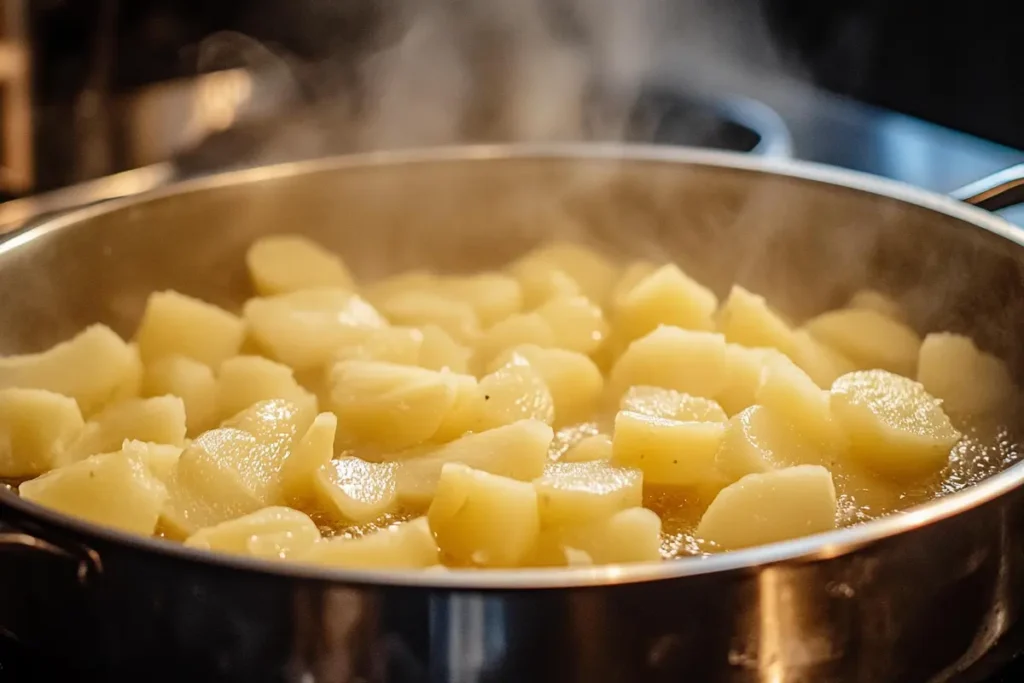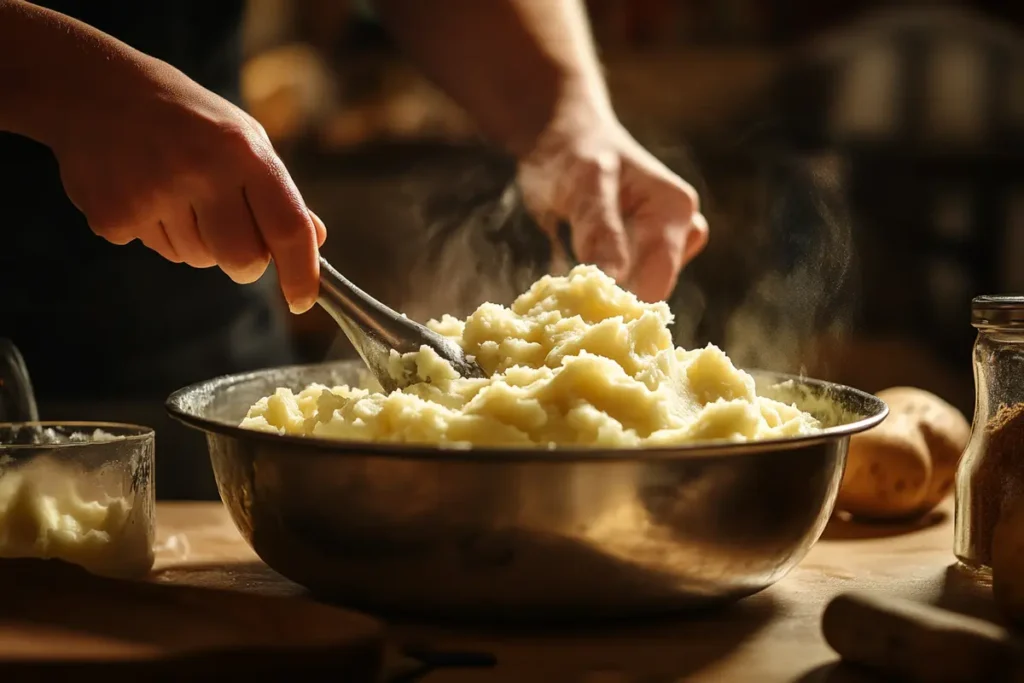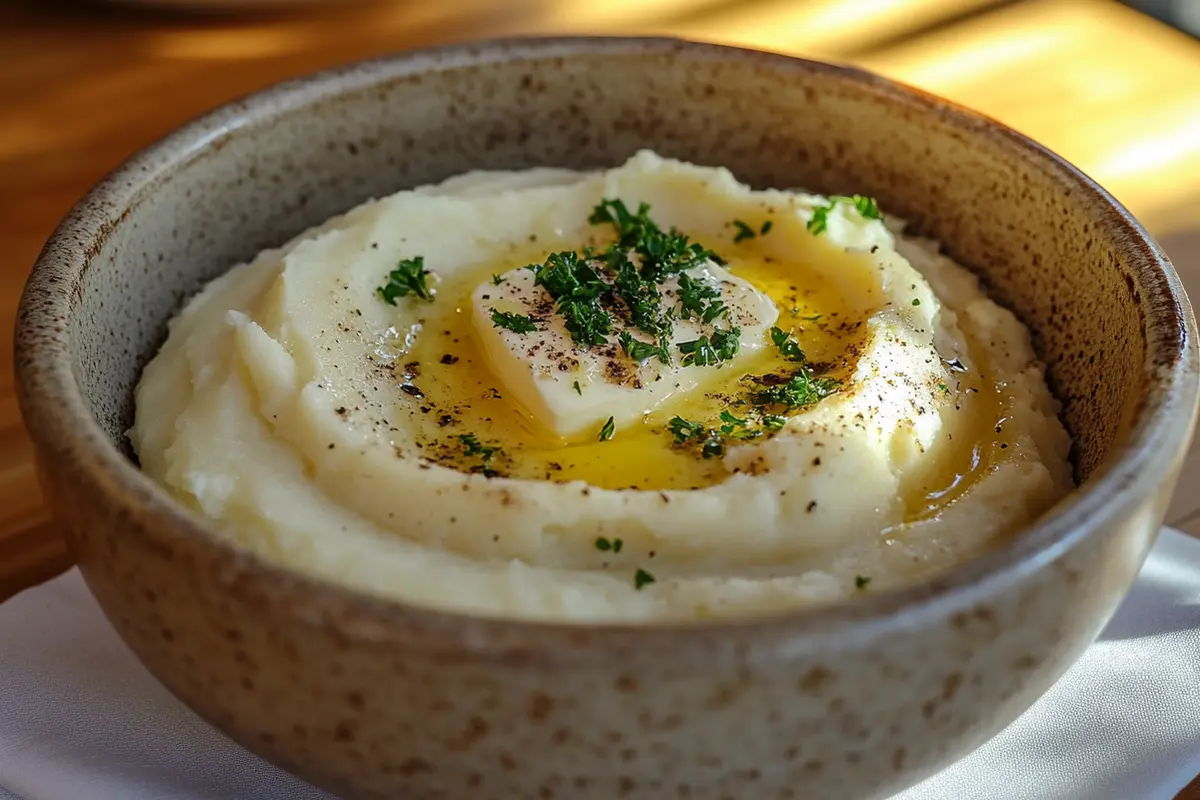The Best Mashed Potatoes Recipe: Creamy, Fluffy, and Perfect
Who doesn’t love mashed potatoes? They’re the ultimate comfort food, seamlessly gracing tables at family dinners and festive feasts alike. However, achieving the best mashed potatoes recipe requires much more than just boiling and mashing. It’s about striking the perfect balance between creaminess, fluffiness, and flavor. With the right techniques, even a novice cook can turn this simple dish into a crowd-pleasing masterpiece.
In this article, we’ll guide you through every essential step, from selecting the ideal potatoes to mastering mashing techniques. Along the way, we’ll also highlight common pitfalls and how to avoid them, ensuring your results are always smooth and delicious. Additionally, you’ll discover a variety of creative variations to suit any occasion. By the end, you’ll have a go-to recipe that not only delights but also impresses even the toughest food critics. Let’s get started!
Introduction to Mashed Potatoes
The Universal Appeal of Mashed Potatoes
Mashed potatoes are more than just a side dish; they’re a culinary staple loved across cultures and cuisines. Creamy, fluffy, and packed with flavor, they bring comfort and joy to every bite. Whether paired with roast turkey, steak, or simply enjoyed on their own, mashed potatoes have a way of stealing the show.
But why are they so universally adored? It’s their versatility. You can keep them simple or jazz them up with herbs, cheese, and garlic. Plus, they’re a crowd-pleaser—there’s hardly anyone who can resist a spoonful of this pillowy delight.
The Importance of a Perfect Recipe
While mashed potatoes might seem straightforward, it’s surprisingly easy to get them wrong. Too watery, too lumpy, or too bland—mistakes can ruin the dish. That’s where having the best mashed potatoes recipe becomes a game-changer. It’s all about using the right ingredients, mastering techniques, and avoiding common mishaps.
In the following sections, we’ll break down every step, so you can make mashed potatoes that are truly unforgettable. Let’s dive into the secrets of this beloved dish!

Essential Ingredients for the Best Mashed Potatoes
Choosing the Right Potatoes
When it comes to the best mashed potatoes recipe, the type of potato you choose makes a world of difference. Russet potatoes, known for their fluffy texture, or Yukon Golds, celebrated for their buttery flavor, are top contenders. Both varieties have high starch content, which creates that smooth and creamy consistency everyone craves.
Avoid waxy potatoes like Red Bliss—they tend to result in dense and gummy mashed potatoes. For a blend of texture and flavor, you can even mix Russets and Yukon Golds.
Butter, Cream, and Other Dairy Products
The secret to indulgent mashed potatoes lies in the quality of your dairy. Use unsalted butter for control over seasoning, and go big—don’t skimp. Heavy cream or whole milk is ideal for richness, but half-and-half works if you’re looking to lighten things up slightly. Adding sour cream or cream cheese gives your mashed potatoes an extra tangy kick.
For dairy-free versions, substitute with almond milk, oat milk, or coconut cream to maintain a luxurious texture.
Flavor Boosters: Garlic, Herbs, and Beyond
While classic mashed potatoes shine in their simplicity, a few enhancements can elevate the flavor. Roasted garlic adds depth, fresh chives bring a mild oniony taste, and thyme or rosemary provides an earthy note. A pinch of white pepper or nutmeg can subtly enhance the dish’s complexity.
For additional inspiration, check out this Potato Gratin with Truffle Magic recipe for flavor ideas.
Step-by-Step Instructions for the Best Mashed Potatoes
Preparing the Potatoes: Washing, Peeling, and Chopping
To begin, scrub the potatoes thoroughly under cold water to remove any dirt. Next, peel them if you want a smooth texture, or alternatively, leave the skins on for a rustic appeal. Then, cut the potatoes into uniform chunks to ensure even cooking. If the pieces are too large, they’ll take forever to cook; conversely, chopping them too small may cause them to become waterlogged.
Cooking Methods: Boiling vs. Steaming
Once your potatoes are chopped, place them in a pot of cold, salted water. Always start with cold water to guarantee even cooking; otherwise, starting with hot water could lead to inconsistencies. Afterward, bring the water to a gentle boil and cook the potatoes for about 15–20 minutes until they’re fork-tender.
Alternatively, you can try steaming. Not only does this method prevent the potatoes from absorbing too much water, but it also helps maintain a lighter, fluffier texture.
Mashing Techniques: Tools and Tips
Now comes the fun part: mashing. For the smoothest and most velvety mashed potatoes, opt for a potato ricer or a food mill. These tools break down the potatoes effectively without overworking them. If you prefer a heartier, chunkier texture, however, a hand masher will do the trick. Be cautious with electric mixers, as overmixing can release too much starch and transform your potatoes into a gluey mess.
Seasoning and Adjusting for the Perfect Taste

Finally, it’s time to season your mashed potatoes. Begin by seasoning generously with salt and pepper as you mash, and gradually mix in melted butter and warmed cream or milk. Always use warmed liquids, as they integrate more smoothly, creating a luscious consistency. As you go, taste frequently and adjust the seasoning until your mashed potatoes are perfectly balanced.
Looking for creative serving ideas? Pair your mashed potatoes with recipes like this Meatloaf Without Eggs for a complete comfort meal.
Common Mistakes and How to Avoid Them
Overmixing and Turning Potatoes Gluey
One of the most common pitfalls when making the best mashed potatoes recipe is overmixing. While you might think more mixing equals creamier results, it actually has the opposite effect. Overmixing releases too much starch, turning your potatoes into a sticky, gluey mess. Instead, use a potato ricer or a gentle hand masher, and mix only until smooth.
Underseasoning: When to Add Salt
Another frequent mistake is underseasoning. Potatoes have a mild flavor, so they need a generous amount of seasoning to truly shine. Add salt to the cooking water, just like you would when boiling pasta. Then, season the mashed potatoes gradually as you mix in butter and cream. Tasting as you go ensures your final dish is perfectly balanced.
Variations of Mashed Potatoes
Garlic Mashed Potatoes
For a flavorful twist, garlic mashed potatoes are hard to beat. Simply roast a few garlic cloves until golden and soft, then mash them into your potatoes along with butter and cream. The roasted garlic adds a subtle, nutty sweetness that elevates the dish.
Cheesy Mashed Potatoes
If you’re a cheese lover, this variation is a must-try. Stir in shredded cheddar, Parmesan, or cream cheese for a creamy, tangy upgrade. Be sure to fold the cheese in while the potatoes are still hot—it’ll melt beautifully, creating a velvety texture.
Vegan and Dairy-Free Options
Dairy-free mashed potatoes can be just as indulgent. Swap butter with vegan alternatives like olive oil or plant-based spreads, and use almond milk or oat milk for creaminess. Coconut cream can also lend a rich texture, though it adds a subtle sweetness.
For more creative recipes, explore options like this Air Fryer Roasted Potatoes, which pairs well with any mashed potato dish.
Tips for Storing and Reheating
Reheating for Retained Flavor and Texture
Reheating mashed potatoes without compromising their texture is easier than you might think. For smaller portions, the microwave works quickly and effectively—just heat in 30-second intervals, stirring after each session to ensure even heating. Alternatively, for larger quantities, the stovetop often yields the best results. To do this, heat the potatoes in a saucepan over low heat, stirring frequently to prevent sticking. As you reheat, don’t forget to add a splash of milk or cream to bring back their creamy texture.
For an extra-special twist, consider baking the leftovers in an ovenproof dish topped with a layer of melted cheese. Not only does this reheating method preserve the best mashed potatoes recipe, but it also transforms the leftovers into a brand-new indulgent treat.
Reheating for Retained Flavor and Texture
Reheating mashed potatoes without ruining their texture is easier than it seems. For smaller portions, the microwave is a quick solution—just heat in 30-second intervals, stirring in between to ensure even heating. On the other hand, for larger quantities, the stovetop is your best bet. Heat the potatoes in a saucepan over low heat, stirring frequently to prevent sticking. To restore their creamy texture, add a splash of milk or cream as needed.
For an extra-special twist, try baking the leftovers in an ovenproof dish with a layer of melted cheese on top. This reheating hack not only preserves the best mashed potatoes recipe but also transforms it into an entirely new and indulgent dish.months.
Reheating for Retained Flavor and Texture
Reheating mashed potatoes without ruining their texture is easier than it seems. For smaller portions, the microwave is a quick solution—just heat in 30-second intervals, stirring in between to ensure even heating. On the other hand, for larger quantities, the stovetop is your best bet. Heat the potatoes in a saucepan over low heat, stirring frequently to prevent sticking. To restore their creamy texture, add a splash of milk or cream as needed.
For an extra-special twist, try baking the leftovers in an ovenproof dish with a layer of melted cheese on top. This reheating hack not only preserves the best mashed potatoes recipe but also transforms it into an entirely new and indulgent dish.

FAQs Section
How Do I Make My Mashed Potatoes Creamier?
Achieving ultra-creamy mashed potatoes starts with choosing the right potato, like Russets or Yukon Golds. Using warm butter and cream ensures everything blends smoothly. Tools matter, too—opt for a potato ricer or food mill for the best results. Avoid overmixing, as this can make the texture gluey.
What’s the Best Potato for Mashed Potatoes?
Russets are ideal for fluffy, light mashed potatoes, while Yukon Golds add a naturally buttery flavor. If you’re undecided, mix the two for the best of both worlds. Always steer clear of waxy varieties like Red Bliss, which can result in a dense, gummy consistency.
Can I Make Mashed Potatoes Ahead of Time?
Absolutely! Mashed potatoes can be made a day in advance. Store them in the refrigerator in an airtight container. When reheating, add a splash of milk or cream and stir gently to restore their creamy texture.
Why Did My Mashed Potatoes Turn Sticky?
Sticky mashed potatoes are usually the result of overmixing. Using tools like a blender or food processor can overwork the starches in potatoes, leading to a gluey texture. Stick with a gentle hand masher or a potato ricer for the perfect balance of fluffiness and creaminess.
Conclusion
Why This Recipe Stands Out
At the heart of every great meal lies a dish that brings people together, and the best mashed potatoes recipe does just that. With its perfect balance of creamy texture, rich flavor, and customizable options, this recipe is truly a game-changer. Whether you’re hosting a holiday feast or preparing a cozy family dinner, these mashed potatoes will leave your guests raving.
Encouragement to Try and Experiment
The beauty of mashed potatoes is their versatility. While this recipe is a fantastic foundation, don’t hesitate to get creative. Add your favorite herbs, experiment with cheese, or even try out vegan versions. Cooking is all about personalization and joy, so make this recipe your own and enjoy every creamy bite.
Final Tips for Mastering Mashed Potatoes
Consistency Is Key
One of the secrets to the best mashed potatoes recipe is consistency—both in texture and flavor. Be mindful of the potato type, liquid measurements, and seasoning balance. Always taste as you go to ensure a perfectly seasoned dish.
Practice Makes Perfect
Like any great recipe, mastering mashed potatoes takes a little practice. However, don’t be discouraged if your first batch isn’t flawless. Instead, focus on learning from each attempt, as this will bring you closer to creating the creamy, fluffy, and flavorful potatoes that everyone loves. Over time, you’ll find that small adjustments, such as tweaking the seasoning or mashing technique, can make a big difference. Ultimately, the key is persistence, and with a bit of patience, you’ll soon be making mashed potatoes that are truly unforgettable.
For more inspiration and complementary recipes, explore creative ideas like pairing your mashed potatoes with Holiday Turkey Recipes or indulgent Gravy Sauces.

